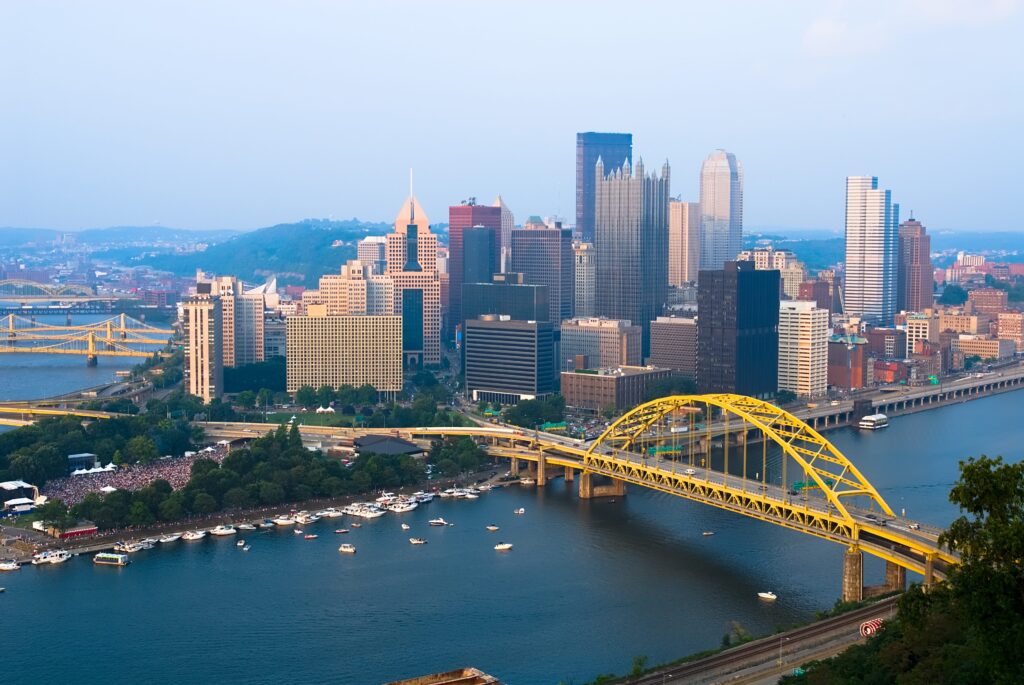Coatings and Technologies For a Resilient Future: Technical Highlights from the 2025 CoatingsTech Conference
By , Ph.D.
The American Coatings Association’s 2025 CoatingsTech Conference took place April 28-30 at the Omni William Penn Hotel in Pittsburgh, Pa., with 242 attendees from industry and academia gathering for three days of learning, sharing ideas, and networking. The conference featured the latest in coatings science and technology embracing the theme, “Coatings and Technologies for a Resilient Future.”
The event kicked off with four short courses, taught by industry and academic experts. This year’s conference sessions included 35 advanced technical sessions with a multi-track format. Session topics focused on protective coatings, architectural coatings, functional coatings, industrial and specialty coatings, analytical methods and artificial intelligence, bio-based and renewable materials, durability, and coating applications technology.
The conference also hosted a poster session, mainly from university students, displaying ongoing and emerging coatings research. The presentations and posters provided a broad spectrum of subjects that supported the conference theme. This article highlights some of the notable presentations and technologies offered over the first two days of the conference.
In addition to the primary theme of resilience, other popular topics throughout the conference were: corrosion protection, durability, lower and safer emissions, antimicrobial, fouling release, specialty additives, testing, and characterization techniques.
The concurrent multi-track format enabled attendees to customize their schedules on specific topic areas, featuring presentations from raw material suppliers, paint manufacturers, government laboratories, and academia, including presentations from Iowa State University, California Polytechnic State University, Eastern Michigan University, North Dakota State University, and Covenant University located in Nigeria.
Keynote Address
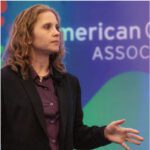 Andrea Wagner Watts, building science education manager at GAF, presented the conference’s keynote address, titled “Future-proofing Buildings: Pushing the Envelope Towards a More Resilient Future.” Her presentation stressed that improving overall performance of building enclosures must be accomplished through application innovation, product development, and building science research. Watts shared insights on how coatings are critical to improving the overall performance of buildings through application innovation. She noted that the construction of a product, building, roof, etc., not only needs to be sustainable and durable, but it also needs to be resilient.
Andrea Wagner Watts, building science education manager at GAF, presented the conference’s keynote address, titled “Future-proofing Buildings: Pushing the Envelope Towards a More Resilient Future.” Her presentation stressed that improving overall performance of building enclosures must be accomplished through application innovation, product development, and building science research. Watts shared insights on how coatings are critical to improving the overall performance of buildings through application innovation. She noted that the construction of a product, building, roof, etc., not only needs to be sustainable and durable, but it also needs to be resilient.
2025 American Coatings Award
The American Coatings Award for outstanding conference paper recognized “Low-Field (LF)-NMR Liquid Relaxation—A Useful Technique for QC and to Determine the Equivalency of Materials for Coatings Formulations” by David Fairhurst, president of Colloid Consultants, Ltd., and coauthored by Ravi Sharma, principal research fellow at Mageleka Inc., and Ralph Jan Wörheide, president and founder of Metromation Inc. (See page 12.) The paper underscores the complexity of coating formulations due to numerous ingredients, their interactions, and the complicated process of dispersion and the importance of quality control in obtaining consistent optimum performance and cost benefits, especially with the potential for raw material substitutions and process changes. Fairhurst described using LF-NMR as a QC tool and provided case studies demonstrating its valuable application.
Mattiello Award Lecture
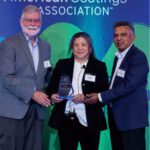 Lipiin Sung of the National Institute of Standards and Technology (NIST), an international expert on scratch and mar testing, the physical degradation of coatings in the environment, and the use of nanotechnology in coatings, was presented the prestigious Mattiello Memorial Lecture Award. This award recognizes an individual who has made outstanding contributions to science, technology, and/or engineering related to the coatings industry. On the conference’s second day, Sung delivered the Mattiello Memorial Lecture, titled “Measurement Science for Coatings: From Color Appearance to Long-Term Durability Assessment.” This presentation supported the conference special session on Service Life Prediction.
Lipiin Sung of the National Institute of Standards and Technology (NIST), an international expert on scratch and mar testing, the physical degradation of coatings in the environment, and the use of nanotechnology in coatings, was presented the prestigious Mattiello Memorial Lecture Award. This award recognizes an individual who has made outstanding contributions to science, technology, and/or engineering related to the coatings industry. On the conference’s second day, Sung delivered the Mattiello Memorial Lecture, titled “Measurement Science for Coatings: From Color Appearance to Long-Term Durability Assessment.” This presentation supported the conference special session on Service Life Prediction.
Student Poster Winners
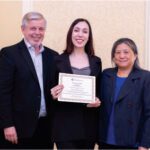 Three students were recognized for their outstanding posters displayed and presented during the conference. “Water Transport Mechanisms in Commercially Available Biobased Polymer Films,” by Ayda Dadras of North Dakota State University, won first place. “Corrosion-resistant Soybean Extract Containing Fluoropolymer Coatings” by Marcel Roy Domalanta of North Dakota State University won second place. “Wear-Resistant Bilayer Surface Design for Scale-Independent De-Icing” by Jiayue Huang of the University of Michigan came in third.
Three students were recognized for their outstanding posters displayed and presented during the conference. “Water Transport Mechanisms in Commercially Available Biobased Polymer Films,” by Ayda Dadras of North Dakota State University, won first place. “Corrosion-resistant Soybean Extract Containing Fluoropolymer Coatings” by Marcel Roy Domalanta of North Dakota State University won second place. “Wear-Resistant Bilayer Surface Design for Scale-Independent De-Icing” by Jiayue Huang of the University of Michigan came in third.
Conference Presentation Highlights
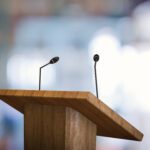 Although the entirety of this year’s presentations cannot be summarized here, we highlight some of the outstanding contributions.
Although the entirety of this year’s presentations cannot be summarized here, we highlight some of the outstanding contributions.
Ray Fernando of California Polytechnic State University presented “Colorant Effects on Solar Reflectivity and Rheology of Exterior Architectural Coatings.” The objective of this study was to identify effects of pigments and fillers to maximize solar reflectivity while maintaining other required properties. Fernando’s work identified coating ingredients and application parameters to increase solar reflectivity of exterior wall coatings.
Diana Alves from International Iberian Nanotechnology Laboratory presented “A Mussel-Inspired Approach to Impart Fabrics with Superhydrophobic and Easy-Cleaning Features,” which described an innovative treatment concept to improve cleanability of polyester and cotton fabrics, thereby potentially increasing their service life.
Shih-Wa Wang from Axalta Coating Systems presented “Coatings for Drop-on-Demand (DOD) Application Technology as a Sustainable Solution for Vehicle Customization.” The presentation explained and demonstrated the application of DOD inkjet technology for auto applications to enable high resolution, on-demand customization while improving paint shop efficiency and sustainability.
Continuing on the automotive coatings theme, Yuejun Zhao from PPG presented “UV-Durable Hydrophobic Coatings for Enhanced Sensor Performance in ADAS and Autonomous Vehicle Systems.” Zhao emphasized that autonomous vehicles demand highly reliable sensors. To address these challenges, a durable hydrophobic coating has been designed and successfully evaluated under simulated and real-world conditions including fog, rain, mud, insect splatter, and off-road terrain while operating the vehicle at representative speeds. The coating reduced environmental contamination on sensors, enhanced imaging, target recognition, and signal clarity.
Dr. Lichang Zhou from Syensqo presented “Enhancing Coating Performance without Using Fluorocarbon Surfactants in Water-Based Formulations.” The presentation demonstrated new phosphate ester wetting agents that can replace fluorocarbon surfactants in waterborne coatings and provide colloidal stability, wetting, dispersing, and hot block resistance.
Lucille Wells from the U.S. Naval Research Laboratory presented “Isocyanate-Free Polyurethane-Siloxane Networks Based on Partially Renewable Binders.” This presentation described the development of isocyanate-free polyurethane-silane binders, which formed cross-linked hybrid networks with attractive thermal and mechanical properties.
Jennifer Mills of Dow Chemical introduced “Methods to Determine Open Time of Architectural Coatings.” Mills described a new applied test method, brush workability, to determine open time and wet edge of coatings. She demonstrated that the test procedure offers good reproducibility and a high level of differentiation with validated results that correlate with real-world application of commercial architectural paints.
Mary Chervenak presented “A Waterborne Exterior Wood Coating that Eliminates the Need for ’VOC Exempt’ Solvents.” This presentation introduced a polymer that can be used in coatings for exterior wood substrates, with water instead of these solvents. The presentation demonstrated that the new polymer and subsequent coating provide exceptional protection to exterior wood substrates.
Charles Hegedus, Ph.D., is a coatings industry consultant and serves as technical editor for both CoatingsTech and the Journal of Coatings Technology and Research. Email: hegeducr@gmail.com
Service Life Prediction Symposium
By Kurt Wood
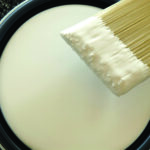 The third and final day of the 2025 CoatingsTech Conference featured a special symposium focused on the durability and Service Life Prediction (SLP) of Coatings. Organized by a team of industrial, academic, and National Laboratory scientists and engineers, the program was convened in the spirit of a series of International Conferences on Service Life Prediction held between 1997 and 2017. That series was organized by a group at the National Institute of Standards and Technology (NIST) and with many attendees of the original conferences having retired, or soon to be retired, the organizers believed that the proven risk reduction principles of SLP methods need to be reintroduced to a new generation of scientists and decision makers.
The third and final day of the 2025 CoatingsTech Conference featured a special symposium focused on the durability and Service Life Prediction (SLP) of Coatings. Organized by a team of industrial, academic, and National Laboratory scientists and engineers, the program was convened in the spirit of a series of International Conferences on Service Life Prediction held between 1997 and 2017. That series was organized by a group at the National Institute of Standards and Technology (NIST) and with many attendees of the original conferences having retired, or soon to be retired, the organizers believed that the proven risk reduction principles of SLP methods need to be reintroduced to a new generation of scientists and decision makers.
Leading up to the symposium, the CoatingsTech plenary talks on Monday and Tuesday set the stage for the Wednesday SLP Symposium. Andrea Watts’ keynote talk on Monday, “Future-proofing Buildings: Pushing the Envelope Toward a More Resilient Future,” explored the connection between long material service life, and the broader concept of “resiliency.” Tuesday morning’s Mattiello Award Lecturer was Lipiin Sung of NIST, who has spent much of her career in the NIST Building and Fire Research Lab that has led the way in developing new SLP methods. Additionally, the Technical Focus Lecture by Mark Nichols of Ford, “Service Life Prediction of Coatings: A Vehicle Manufacturer’s Perspective,” outlined the steps that industry took to create today’s high-performance basecoat-clearcoat systems. The topic of service life prediction was also the focus of a number of student posters.
The SLP Symposium attracted nearly 100 attendees. Sung and retired industrial scientist Kurt Wood set the tone for the day by reviewing the general principles of SLP and highlighting some current issues in the field. Oscar Cordo of Atlas Materials Testing discussed how test methods and standards are connected to, but different from, SLP. Jennifer David of Momentive illustrated how SLP methodologies were used to develop very thin durable hardcoats to protect automotive glass. The morning session ended with a wide-ranging presentation by Erik Sapper of Cal Poly San Luis Obispo, exploring different ways that Machine Learning and Artificial Intelligence might be used to optimize SLP research.
The afternoon talks demonstrated how SLP principles are being applied to particular problems in coatings and coatings-adjacent applications. Sean Fowler of Q-Lab, Inc. presented new data from a long-running protective coatings industry study comparing different accelerated weathering methods against Florida exposure. Don Lawson of AGC Americas discussed how the company uses Electrochemical Impedance Spectroscopy to non-destructively probe the evolution of coating system barrier properties in real time during accelerated testing. Karen Schultz of Boeing recounted the aircraft industry’s contribution to the development of the ASTM D7869 accelerated test. Peter Hacke of NREL presented work conducted by a photovoltaic industry consortium to develop a new “Combined Accelerated Stress Test” suitable for photovoltaic (PV) components as well as coatings used in those applications. Finally, Anish Tuteja of the University of Michigan unpacked the challenges of designing durable ice shedding surfaces.
The afternoon session concluded with a group discussion brainstorming about future directions for the SLP community.
Persons interested in receiving notifications of future SLP events may contact Kurt Wood at kurt.wood.LLC@gmail.com.
Dr. Kurt Wood is a coatings industry consultant with more than 30 years of experience developing resins for industrial coatings, first with the Rohm and Haas Company, then with Arkema, Inc.
